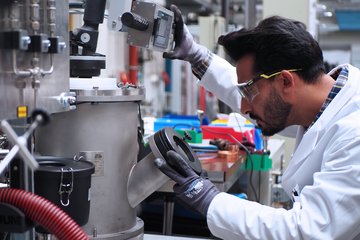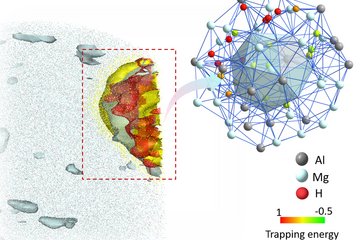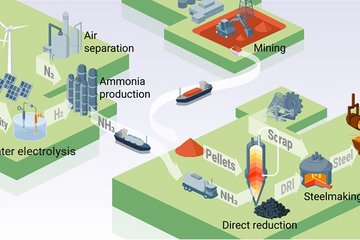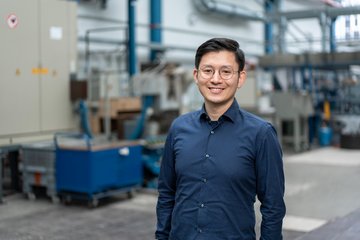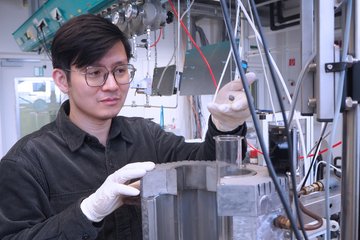Alle Typen
21.
Vortrag
Using in-situ metallic coating to overcome challenges in analyzing poorly conductive and brittle fragile samples by atom probe tomography. 5th European APT Workshop, Marseille, France (2025)
22.
Vortrag
New insights into the reactive liquid-solid interface during magnesium corrosion using cryo-atom probe tomography. EUROCORR 2025 Annular Congress of the European Federation of Corrosion, Stavanger, Norway (2025)
23.
Vortrag
Atom Probe Tomography - a new approach to provide new insights into the interfacial reaction at the liquid-solid interface on the atomic scale. Institute Seminar FAU Erlangen-Nuremberg, Department of Materials Science, Erlangen-Nuremberg, Germany (2025)
24.
Vortrag
Improvement in data quality of biominerals by in-situ metallic coating of APT specimens. Atom Probe Tomography & Microscopy (APT&M) 2025, Chennai, India (2025)
25.
Vortrag
Atom Probe Tomography - the ability to analyse materials with 3D compositional mapping at near atomic resolution. Seminar Frauenhofer Institute for Manufacturing Technology and Advanced Materials IFAM, Dresden, Germany (2025)
26.
Vortrag
Atom probe tomography - a new approach to understand corrosion mechanisms at liquid-solid interface on the near-atomic scale. Institute for Bulidng Materials Seminar, ETH Zurich, Zurich, Switzerland (2025)
27.
Vortrag
Innovative aspects of sample preparation for APT specimens. University of Grenoble, Institute Seminar, Grenoble, France (2025)
28.
Vortrag
Atom probe tomography – a new technique to understand biominerals/materials on the atomic scale. 8th BioMAT 2025 - Symposium on Biomaterials and Related Areas, Weimar, Germany (2025)
29.
Vortrag
Cryo-APT opens up new possibilities in materials analysis. From the atom to the bulk: Materials characterization with CAMECA, Gatan, and EDAX user-day, Weiterstadt, Germany (2025)
30.
Vortrag
cryo-atom probe tomography; quasi-'in situ' analysis of the reactive liquid-solid interface during Mg corrosion. 16th Biometal 2024 Symposium, Krakow, Poland (2024)
31.
Vortrag
cryo-atom probe tomography; quasi-'in situ' analysis of the reactive liquid-solid interface during Mg corrosion. 9th NRW-APT user meeting, MPIE, Düsseldorf, Germany (2024)
32.
Vortrag
Introduction to (cryo)-atom probe tomography and its applications. Belgium Physical Society meeting, Bruessles, Belgium (2024)
33.
Vortrag
In-situ cryogenic protective layers and metal coatings in cryogenic FIB. IMC20 - 20th International Microscopy Congress - Pre-congress workshop, Cryogenic Atom Probe Tomography, Busan, South Korea (2023)
34.
Vortrag
Site-specific preparation and atom probe tomography of bulk water ice and amino acid solutions. Atom Probe Tomography & Microscopy, Leuven, Belgium (2023)
35.
Vortrag
Atom probe tomography: from water to complex liquids to the application of studying liquid-solid interfaces at the near atomic level. APT&M 23, Leuven, Belgium (2023)
36.
Vortrag
Site-specific preparation and atom probe tomography of frozen liquids. IMC20 - 20th International Microscopy Congress, Busan, South Korea (2023)
37.
Vortrag
GIS-free metal coating in cryo-FIB: methods and use cases. IMC20 - 20th International Microscopy Congress, Busan, South Korea (2023)
38.
Vortrag
APT towards liquid-solid interfaces to study early-stage corrosion mechansim. 9th NRW-APT user meeting, Düsseldorf, Germany (2023)
39.
Vortrag
Observations on Improved Cryogenic Lift-Out Methods: Optimised Sample Preparation. Talk at Korea Institute of Science and Technology, Seoul, South Korea (2023)
40.
Poster
cryo-atom probe tomography; quasi-'in situ' analysis of the reactive liquid-solid interface during Mg corrosion. 16th Biometal 2024 Symposium, Krakow, Poland (2024)
